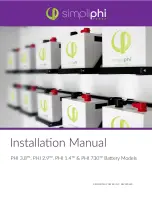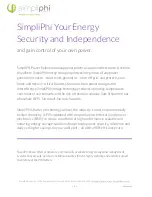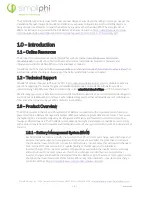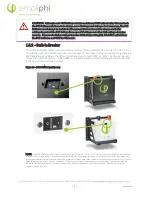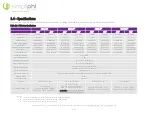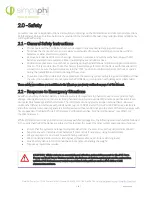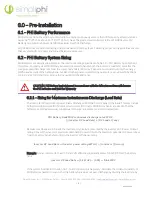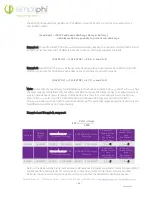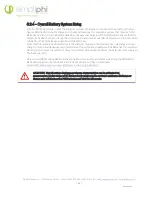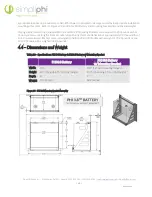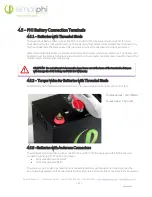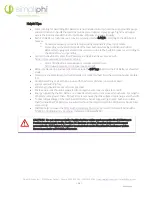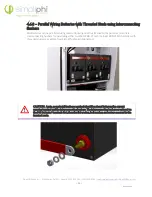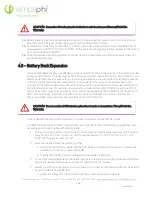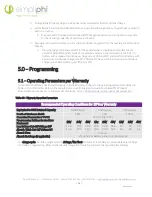
REV020620
SimpliPhi Power, Inc. | 3100 Camino Del Sol | Oxnard, CA 93030, USA | (805) 640-6700 |
| 11 |
discharge. Over-discharging the PHI Batteries will destroy them and Void the Warranty.
In the case where the invert
er’s AC Power Output rating exceeds the connected loads’ actual power draw
(i.e. the inverter is rated at 5 kW but all loads amount to 3 kW of maximum instantaneous power draw),
SimpliPhi still expects that the proper additional precautions be made to ensure that the PHI Battery bank is
not over-discharged. This typically involves the installation of an additional overcurrent protection device
between the PHI Battery bank and the inverter to ensure that the PHI Battery bank does not discharge
beyond its maximum instantaneous power rating. Failure to do so will destroy the PHI batteries and Void
the Warranty.
𝑃𝐻𝐼 𝐵𝑎𝑡𝑡𝑒𝑟𝑦 𝐵𝑎𝑛𝑘 𝑀𝐴𝑋 𝑐𝑜𝑛𝑡𝑖𝑛𝑢𝑜𝑢𝑠 𝑑𝑖𝑠𝑐ℎ𝑎𝑟𝑔𝑒 𝑟𝑎𝑡𝑒
= (𝐵𝑎𝑡𝑡𝑒𝑟𝑦 𝑞𝑢𝑎𝑛𝑡𝑖𝑡𝑦) × (𝑀𝐴𝑋 𝐶𝑜𝑛𝑡𝑖𝑛𝑢𝑜𝑢𝑠 𝐷𝑖𝑠𝑐ℎ𝑎𝑟𝑔𝑒 𝑅𝑎𝑡𝑒 𝑝𝑒𝑟 𝐵𝑎𝑡𝑡𝑒𝑟𝑦)
Example: Two PHI 3.8 kWh-51.2V
nominal
batteries must be installed with an additional 75 ADC-rated
breaker between the battery bank and the inverter.
(𝑃𝐻𝐼 𝐵𝑎𝑡𝑡𝑒𝑟𝑦 𝐵𝑎𝑛𝑘 𝑀𝐴𝑋 𝑐𝑜𝑛𝑡𝑖𝑛𝑢𝑜𝑢𝑠 𝑑𝑖𝑠𝑐ℎ𝑎𝑟𝑔𝑒 𝑟𝑎𝑡𝑒) = 2 × 37.5𝐴𝐷𝐶 = 75𝐴𝐷𝐶
3.2.2
–
Sizing for Maximum Instantaneous Charge Rate (DC Coupled)
In a DC Coupled system, the solar PV array output can be mitigated using charge controllers. However,
reducing the solar array’s power output using charge controller programming implies that the PV array’s
output is also reduced for the entire remainder of the system, including the solar power available for
powering loads and f
or exporting to the grid. Furthermore, greatly reducing the PV array’s output via the
charge controllers effectively wastes the solar PV array’s power and puts strain o
n the charge controllers.
Calculate the minimum quantity of PHI Batteries needed to prevent over-charge from the solar PV array by
considering both the solar array size and the charge controller’s potential output. Whichever value is
less
should be used to
size the PHI Battery Bank. If the solar array’s maximum potential current output is les
s
than the paired charge controller’s Output Amps rating, then the solar array’s maximum potential current
output can be used to size the PHI Battery bank. If the charg
e controller’s Amp rating is less than the solar
array’s maximum potential current output, then the charge controller’s rating is used to size the PHI Battery
bank.
Divide the system’s potential charging current by the MAX Continuous Charge Rate per PHI Ba
ttery (found
in Table 1.0 or on the relevant battery’s specification sheet) to calculate
the minimum quantity of PHI
Batteries needed to ensure that the solar PV array does not over-charge the battery bank.
Example A: Three PHI 3.8 kWh-51.2V
nominal
batteries (used in a 48-Volt system) must be paired with a
4,500-Watt solar PV array wired to an 80 Amp-rated charge controller. In this case, the 80-Amp charge
controller is used to determine the minimum PHI Battery quantity needed to prevent over-charging from
the solar PV.
𝑊𝑎𝑡𝑡𝑠 = 𝐴𝑚𝑝𝑠 × 𝑉𝑜𝑙𝑡𝑠
4,500 𝑊𝑎𝑡𝑡 𝑆𝑜𝑙𝑎𝑟 𝑃𝑉 𝑎𝑟𝑟𝑎𝑦 = 𝐴𝑚𝑝𝑠 × 48 𝑉𝑜𝑙𝑡𝑠
4,500 𝑊𝑎𝑡𝑡𝑠
48 𝑉𝑜𝑙𝑡𝑠
= 𝟗𝟑. 𝟕𝟓 𝐴𝑚𝑝𝑠 = 𝑀𝐴𝑋 𝑝𝑜𝑡𝑒𝑛𝑡𝑖𝑎𝑙 𝑠𝑜𝑙𝑎𝑟 𝑃𝑉 𝑎𝑟𝑟𝑎𝑦 𝑜𝑢𝑡𝑝𝑢𝑡

